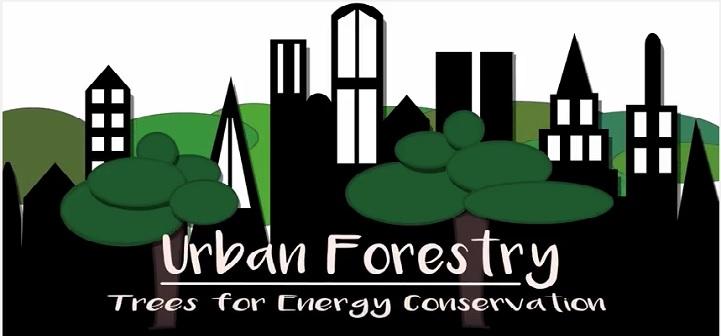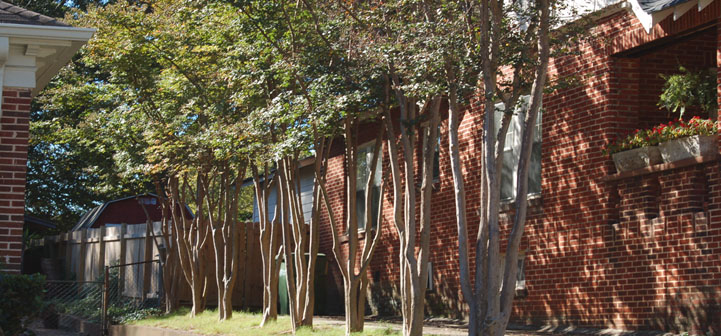
Trees provide more than just beauty or a source of wood products. Rather, trees provide an assortment of economic, environmental, psychological and social benefits to humans. Energy savings are one such highly valued benefit or service urban trees provide. Did you know that just 17% shade on a building from trees for example can reduce power bills by $10/ month or that urban trees can lower surrounding temperatures by as much as 20° F? Alternatively, trees can reduce winter heating costs by 15% through wind control. Correct planning, design, and care for urban trees is essential to maximize their energy conserving benefits.
The National Urban and Community Forestry Advisory Council sponsored the recent development of a video series demonstrating how care for urban forests leads to energy conservation, in support of the Trees for Energy Conservation eXtension website. Watch today and learn from national urban forestry experts across a variety of topics, including:
Communities Benefit from Energy-Saving Trees:
- Urban Forests Role in Heat Reduction
- Trees for Comfort in Public Places
- Finding Refuge in the Urban Forest
- Blending Architecture with the Urban Forest
- Community Involvement with Urban Forestry
Tree Establishment in the Urban Environment:
- Establishing Trees for Energy Conservation
- Staking and Guying Landscape Trees
- Mulching Trees in the Urban Environment
- Watering Trees in the Urban Environment
- Controlling Weeds around Landscape Trees
Communities Benefit from Energy-Saving Trees

In Blending Architecture with the Urban Forest, Florida Extension Forester Robert Northrup discusses how trees create a sense of place; provide a comfortable environment to seek respite in our day-to-day lives; and how well-designed forests lead to notable energy savings. Northrup further explains how the planning and care of trees in the built environment relies on a community of engaged citizens for its success in Community Involvement with Urban Forestry. He points out that “there are costs to the urban forest, but the benefits outweigh those costs, particularly through good, sound management and use of science to guide planning…to produce a multitude of benefits.”

In Finding Refuge in the Urban Forest, Northrup explains how urban forests provide habitat for wildlife, a refuge from the heat and chaos of the city and a source of well-being for city dwellers.
With careful planning, cities can maximize the benefits of urban forests. The video, Trees for Comfort in Public Places, discusses how the city of Tampa has intentionally planned green space in its business districts to encourage people to get outside, which increases shopper foot traffic and boosts worker productivity. He also showcases a “pocket” park where the soil and hardscape has been specially engineered to boost tree growth and longevity, which maximizes shade and comfort. Urban areas tend to be hotter than outlying natural environments, which can impact air quality and human health. Fortunately, urban forests buffer the heat of the sun and cool the urban environment. The Urban Forest’s Role in Heat Reduction describes the urban heating phenomenon and its consequences for people and the environment.
Tree Establishment in the Urban Environment

Auburn University Extension Agent, Arnold Brodbeck, introduces important tree care practices of mulching, watering, weed control, and support for newly planted trees in Establishing Trees for Energy Conservation. These practices are critical to young tree survival and vigor that maximize energy conservation benefits. In subsequent videos, Brodeck looks at each tree care practice in greater detail, providing tips to ensure success with your shade trees.

Mulching Trees in the Urban Environment describes how mulch plays several key roles in supporting urban tree health, including insulating the soil from temperature extremes, retaining soil moisture, providing a nutrient source, and suppressing weeds. In the video, Staking and Guying Landscape Trees, Brodbeck explains the factors that necessitate staking and guying trees and provides guidelines on how to select, install, and maintain them. He points out that staking and guying are important in some situations such as: top-heavy tree crowns, small root balls, or areas with high winds. Proper watering of trees is the most critical factor in the survival of recently transplanted trees. In Watering Trees in the Urban Environment, Brodbeck demonstrates techniques for frequent, slow watering so roots receive sufficient water and wasteful runoff is avoided. Weeds are undesirable plants that grow around the base of shade trees, robbing them of water and nutrients. This can slow the establishment and growth of young trees. In Controlling Weeds around Landscape Trees, Brodbeck discusses the consequences of unchecked weed growth around trees and provides tips on proper weed control, such as mulching and herbicide application.
In addition to these videos, project partners are developing the second phase of this series (Planting Site Assessment and Preparation & Tree Selection and Placement) due to be released in 2017.
Contributors:
H. Campbell, A. Downing, W. Hubbard, P. Jaishanker, E. Wiseman, J. Munsell
References:
Coder, K. 2011. Identified Benefits of Community Trees and Forests. Community Forests Series: WSFNR11-01, University of Georgia. Online At: http://www.warnell.uga.edu/outreach/pubs/all.php
